The New Silk Road:
How China’s Win-Win Approach
Is Transforming the World
Seminar in Paris co-sponsored by the Schiller Institute
and the Geopolitical Academy of Paris, October 24, 2017
by Christine Bierre
November 2017
View full size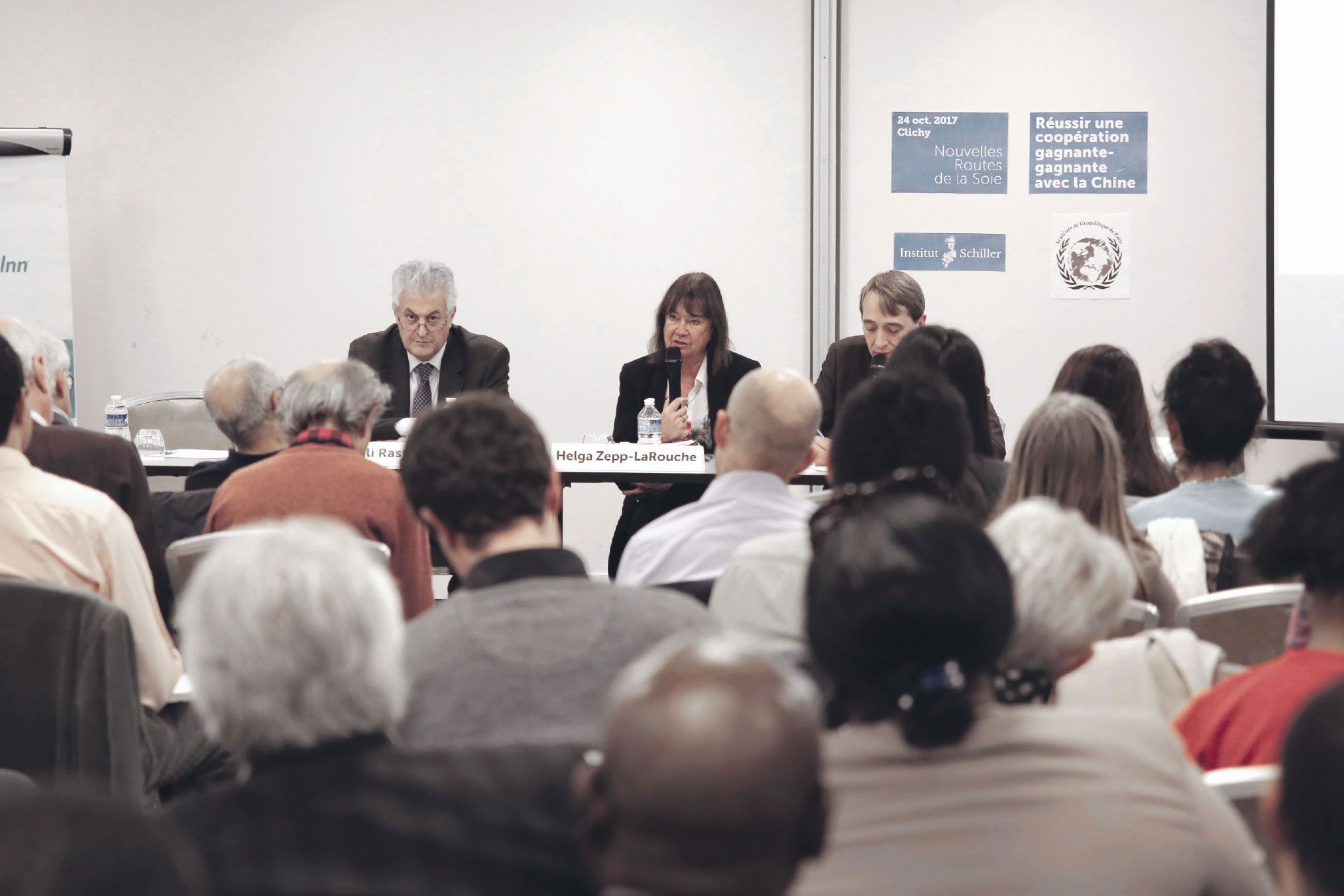 Schiller Institute
Helga Zepp-LaRouche addressing the Oct. 24 seminar in Paris. |
More than a hundred diplomats, experts, business leaders, China specialists, French-China friendship associations, parliamentary attaches, media, students of Far-East civilizations, and French citizens participated in a highly successful seminar held in Paris, on Oct. 24. It was co-organized by the Schiller Institute and the Geopolitical Academy of Paris, on the theme of how China’s New Silk Road win-win approach works and how it is already transforming the world. This intense seminar covered the essentials of the Chinese project, the Confucian philosophy which inspires it, the Hamilton/List/Carey/LaRouche foundation of its economic policies, as well as concrete examples which are already working in Africa, and the recipe for joint Franco-Chinese projects in France and Europe, or abroad.
I. Introductory Remarks by Rastbeen and Zepp-LaRouche
The seminar started with introductory remarks by Ali Rastbeen, president and founder of the Paris Academy of Geopolitics (ACP) and by Helga Zepp-LaRouche, founder of the Schiller Institutes, also known in China and in broad circles internationally, as the Silk Road Lady. “The New Silk Road will make China the leader in world trade and facilitate its trade with Western Europe, its most important partner,” said Rastbeen noting that while on the one hand the project will secure China’s trade routes and energy supplies, it is also an alternative to the present unipolar order. The Chinese project can transform the Middle East. “Relations between China and the Middle East are friendly; they have common visions on a number of regional and international questions, among which is peace and development.” Washington’s policies in the Middle East, on the contrary, limit themselves to two axes: securing its own oil resources and transport routes, and ensuring the military supremacy of its main ally in the region, Israel. Rastbeen noted however, that traditionally China has been a good commercial partner of Israel, including in the purchase of military hardware. China’s Silk Road is therefore a potential venue to easing tensions and creating stability in the region.
View full size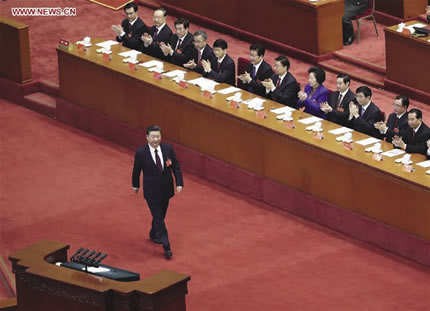 Xinhua
President Xi Jinping, walking to the podium to address the 19th Party Congress. |
Helga Zepp-LaRouche concentrated her remarks (see video or the previous article in this issue for a full transcript) on the far-reaching conclusions of the 19th Communist Party Congress for the future of China and the world, after first establishing her credibility on what the Chinese have accomplished so far. “I had the benefit of being in China for the first time in 1971, during the Cultural Revolution, and therefore I saw personally the most incredible changes the Chinese miracle has represented.”
Since the reforms of Deng Xiao Ping, more than 40 years ago, China has realized the greatest transformation of any country on this planet. China has pulled 700 million people out of extreme poverty, and a middle class has emerged which lives very well. The goals announced by Xi Jinping at the CPC Congress, are that by 2020 China will end extreme poverty, by 2035 it will be a totally modernized country, and by 2050 it will be a “strong, democratic, culturally advanced, beautiful and harmonious nation.” Mrs. LaRouche noted that throughout his speech Xi Jinping had mentioned 14 times that his objective is to provide people a better and happier life. One cannot say, she said, that the right to happiness is a political debate in our Western countries.
What China has done with its New Silk Road policy, is to take its own economic miracle and offer a win-win possibility to all participating countries to realize their own such miracle. And that policy has already transformed numerous countries in Asia, Africa, Latin America, southern and eastern Europe.
While all this is happening, however, the Western media has organized the most incredible barrage to discredit the New Silk Road, accusing China of imperialism, of wanting to hoard the world’s raw materials, and comparing Xi Jinping to Stalin and Mao. This is nothing but the continuation of the policy orientation adopted by the Anglo-American neo-conservatives following the collapse of the Soviet Union, she said, their will to impose a unipolar world through regime change, color revolutions, and theories like the “right to protect.” The neo-liberal policies promoted in the economic domain have led to global impoverishment of the middle class and the population at large, and have provoked the Brexit, Trump, Kurz and Catalonian revolts.
For Mrs. LaRouche, there is an ongoing clash between this unipolar paradigm of civilization and the new win-win paradigm that China and Russia are trying to implement. Mrs. LaRouche outlined how she and her husband, Lyndon LaRouche, in 1991, following the final collapse of the Soviet Union, proposed to connect the European centers of population and of industrial production through industrial corridors of development, which they had called, in 1991, the Eurasian Landbridge or the New Silk Road.
I think that it is in the interest of European nations to cooperate with China and Russia in the Development of Africa, she said, calling this approach “the only humane way of dealing with the refugee crisis. We need a new paradigm of cooperation, and this one is already on the table.”
II. Alternatives to War and Geopolitics
The Confucian Foundation of the New Silk Road policy
View full size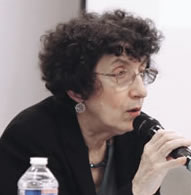
Christine Bierre |
Christine Bierre, editor in chief of Nouvelle Solidarité, showed the antinomy between Geopolitics and the Chinese model of win-win relations. Unfortunately, the term Geopolitics coined in the early XXth century by two Anglo-Saxon imperialists, Halford Mackinder and Karl Haushofer which inspired Hitler’s Lebensraum, has entirely replaced that of “strategy” today, when in reality it is merely a synonym for Might is Right.
The real inspiration for the Chinese win-win model is Confucianism, the ancient moral philosophy of the Chinese whose main value is “love for humanity” and the obligation to perfect oneself, a philosophy specially designed for the education of a virtuous public administration. But in order to understand this, she said, one must understand the Chinese society from the inside. Leibniz was the first to discover that the Western and Chinese civilizations could dialogue via Confucianism. We must today also develop this avenue of thought in order to see how close we are to the Chinese, who are presented to us today as menacing!
The French, in particular, who from ancient rulers to Charles de Gaulle often governed through the Missi Dominici, the officers of the King or the public administration of the day, should be inspired to see the role played by the “erudite” administration of civil servants in ensuring the best possible governments, in dynasties associated with Golden Age and with the strong development of the Silk Road, such as in the Han dynasty (206 BC -220 AD), the Tang dynasty (618- 957AD), and the Song dynasty (957-1259AD). Bierre went through the strong scientific, industrial and artistic development of these epochs, comparable however in many ways to the Grand Designs of Charlemagne, Colbert and Charles de Gaulle in Europe. It is by readopting our true identity that we will stop fearing China and enter a partnership with it instead.
Space: The Common Aims of Mankind in the 21st Century
View full size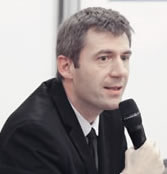
Sebastien Drochon |
The fight against geopolitics and for the common aims of mankind goes through an ambitious space exploration policy, said Sebastien Drochon of the Schiller Institute science team in France. This is a fight that we have waged for a long time, and that China is carrying out on its own.
Drochon started with a beautiful quote from the great Krafft Ehricke, the German engineer and pioneer, with Wernher von Braun, of manned space travel. Ehricke, in his “Anthropology of Astronautics” stated, “The concept of space travel carries with it enormous impact, because it challenges man on practically all fronts of his physical and spiritual existence.” He believed that when confronted to the limits of a given system and forced to change, the universe gives us the means to overcome the limits.
View full size Yutu rover. |
Drochon gave an overview of the Chinese space program: the Yutu rover landing on the moon in 2013; the ongoing preparations for a moon landing and return with lunar samples; and a moon landing of another rover on the far side of the moon in 2019. Why the far side? The moon has no atmosphere and the far side is relatively protected from noisy radio waves coming from the earth. It is there that the equipment allowing us to access the universe, in the very low frequencies, can be set up. It would open our eyes to the thermal signature of certain radio sources in the Milky Way, to the coherent radio signature of clusters of invisible plasmas in space, and of vast magnetic structures connected to those plasmas.
View full size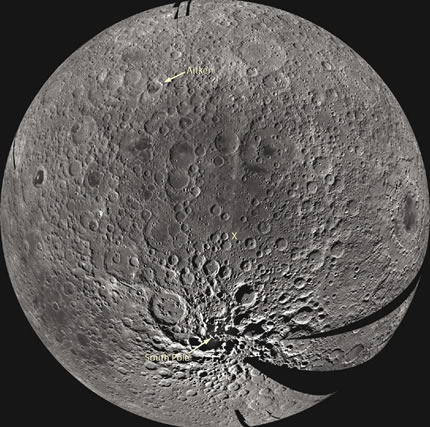 NASA
The South Pole and Aitken basin on the dark side of the Moon. |
One of the deepest craters of the solar system, on the far side of the moon, the South Pole of the Aitken basin, 6 km deep, would be the ideal place to study lunar geology and also to carry out experiments on deep cold and vacuums. Along with the just discovered giant 200 meter large cave with 50 km length, these both would be ideal for installing the moon village that the European space agency is working on.
Last but not least, Rosatom, the Russian space agency and NASA are both progressing on the question of reducing the time of space travel through nuclear propulsion. Rosatom will test a system in 2018 and NASA says it is working on a prototype that could reach Mars in only 39 days. The team led by Dr Michael Paluszsek at Princeton Satellite Systems is in the test phase of a promising prototype in fusion propulsion, and needs $20 million to make more progress.
III. Ongoing Win-Win Cooperation and the Potential for Much More
Financing Franco-Chinese projects in France or third countries
View full size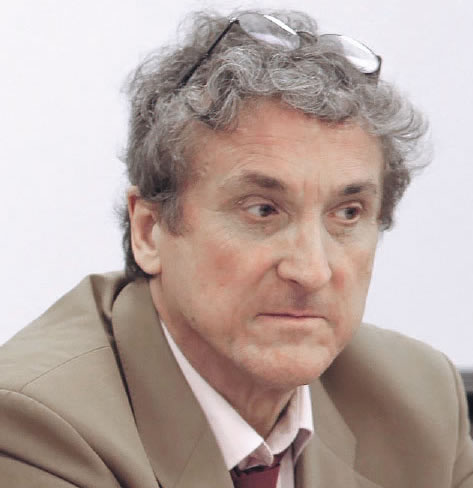 Karel Vereycken |
Karel Vereycken, Director of Publication of Nouvelle Solidarité took up the very practical question of win-win financing, going through some basic information and posing the challenge for France.
Globalization has massively increased Foreign Direct Investment (FDI). Long term financing can be carried out by sovereign funds. Sovereign funds are expected to represent 15% of total global assets by 2020, nearly $15 trillion, and be run by 140 sovereign funds, i.e. managed and/or state owned.
View full size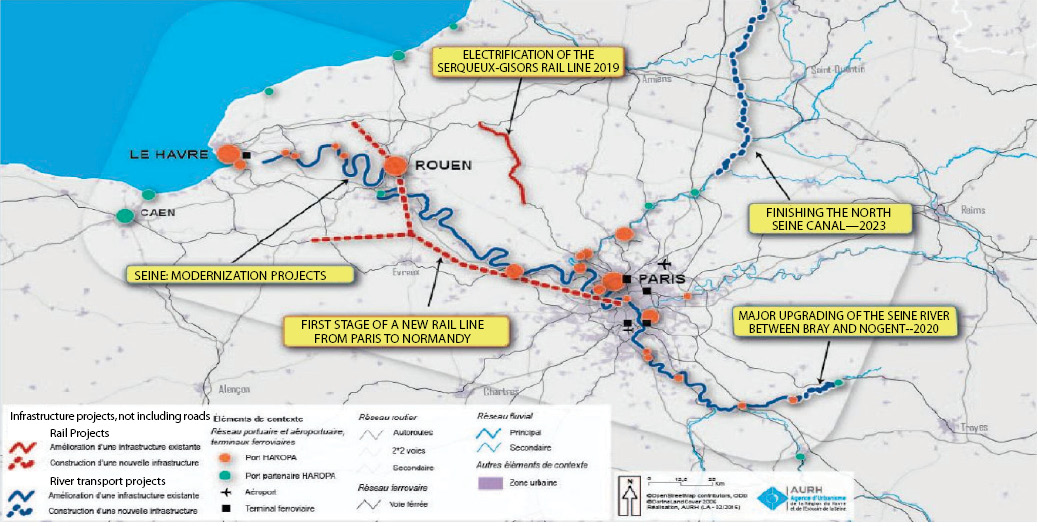
Graphic showing the improvements of existing infrastructure and construction of new infrastructure to greatly expand the French economy by improving the contribution made by the port at Le Havre. |
What attitude should nations take towards FDIs? Total protectionism or an “open bar”? Neither, the third option is to determine the rules of a true win/win system.
How to work with sovereign funds? France has taken several initiatives in this direction. The most interesting was the creation, in 2014, by the French sovereign fund CDC (Caisse de Depots et de Consignations), which holds $400 billion in total assets, of “CDC International Capital” (CDC-IC). This created new types of instruments, “sovereign counterpart funds.” The idea is to match foreign investment with local investment, each contributing equal parts. CDC-IC manages partnerships with the Qatar Investment Authority (QIA), Mubadala, Kingdom Holding Company, China Investment Corporation, Korean Investment Corporation, Russian investment fund, and others.
Some examples: in 2015: CDC-IC and the China Investment Corporation (CIC) jointly invested 2 billion Euros in the Greater Paris project. In late 2017, a tripartite fund of sovereign funds, from Russia, Bahrain and France, saved the famous French glass and crystal manufacturer and distributer, Arc International.
In November 2016, the “Sino-French Third-Countries Investment Fund” which includes Franco-Chinese partnerships in Africa, was created initially with only 300 million Euros, but aims to grow to 2 billion. CDC-IC, without a new policy of sovereign state credit in France, cannot come up with the amounts proposed by China for co-investment. China initially proposed 50 billion Euros, but CDC-IC only had 300 million Euros available.
Vereycken proposed similar investments in infrastructure in France where underinvestment in transport and energy requires at least 250 billion Euros. The urgent needs should start with joint investment with China to improve port infrastructure (dredging, building docks and locks) and building out to the hinterlands (rail and canals). Le Havre, for instance is France’s second port and first container port. But 89% of all containers arriving by ship are then forwarded by road, a much higher proportion than in Antwerp, Rotterdam or Hamburg. Paradoxically, Alsace-Lorraine, because of its proximity to Antwerp, Rotterdam and Hamburg, has better maritime access than Bretagne or Southern France on the Mediterranean. The port of Le Havre is still missing the lock connection of the container port with the inland canal network, which is of the utmost urgency. Separating cargo rail from passenger trains between Le Havre, Rouen, and Paris, and all the way to Germany is also a major challenge. At least 2.5 billion Euros are immediately necessary to avoid a total breakdown. Building a high speed rail, maglev or aérotrain connection between Paris, Rouen, and Le Havre would allow the conversion of the current railway grid to good transport. Conclusion: a good framework of mutual confidence exists, therefore let’s use it and go ahead with it, Vereycken concluded.
Industrialization in Africa under way!
View full size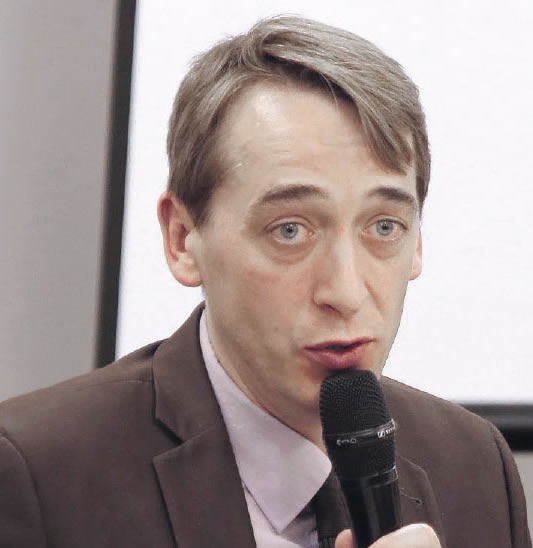
Sebastien Perimony |
Sebastien Perimony, of the Schiller Institute Africa desk in France, attacked the totally false image of Africa, always poor and backwards, never civilized, which has neither history nor heroes! Not only is this image, presented by some French officials, false, but with the emergence of the BRICS and of the China’s One Belt, One Road initiative, Africa has entered into an era of co-development, bringing not only colonization but the bad joke called “development aid” to an end.
A new world is opening up for Africa, as the June 2017, 78-page report by the McKinsey Company, “Dance of the lions and the dragons” reviews. Since the beginning of the millennium, trade between Africa and China has increased by close to 20% each year, and foreign direct investments grew annually during the last decade by 40%. In 2015, China invested $21 billion in African infrastructure and overall investments in infrastructure grew by a 16% annual rate, between 2012 and 2015.
Some examples
Nigeria: On July 2016, Nigeria inaugurated the first high-speed rail line in Western Africa, linking the capital Abuja to Kaduna, 187 km away, at 150 km/h, three times faster than other trains. This line was built by the China Engineering Construction Company (CCECC) and aims at enhancing the economy of Northern Nigeria, which is suffering from the expansion of the Boko Haram cult. Everybody knows that it is economic hardship that pushes youth into the arms of the terrorists and the only solution to that problem is economic development in the region.
View full size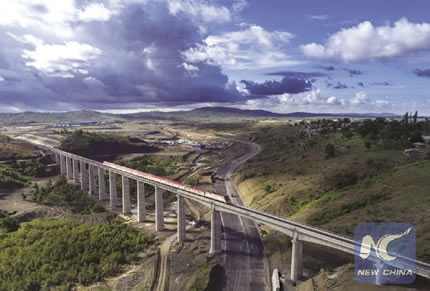 Xinhua
An overpass on the high-speed rail link between the Kenyan port of Mombasa and Kenyan capital Nairobi, built in collaboration with China. |
The Nigerian government and China’s rail giant, China Railway Construction Corporation (CRCC), also signed a $12 billion contract for the construction of a 1,402 km rail line connecting Lagos, Nigeria’s capital, to Calabar in the East of the country, and passing through Harcourt Port and the Warri petrochemical factory. 200,000 people will be employed to complete a project which will employ 30,000 permanently. Ethiopia: The first high-speed rail line in Ethiopia was inaugurated on October 2016. The new 753 km rail line will reduce the time of the Djibouti-Addis-Ababa trip to only 10 hours, as opposed to 7 days previously. On Sept. 14, 2014 the six lane highway connecting Addis-Ababa to Adame, 85 km away was opened. Owned by a public company, the highway was built by China Communications Construction Company (CCCC). This new dynamic has created the conditions for the number of children attending school to double in 10 years, and, during the same period, 30 new universities have been created, and the number of students in higher education has gone from 3,000 to 37,000. Electrical power increased from 350 MW to 2,400 MW and 6,000 new MW will be added to the power grid in 2018 when the Ethiopian Renaissance great dam will be inaugurated. The railway network is also in full expansion, slated to increase from 800 km at present, to 4,000 km in the near future. Also of note, Ethiopia, with the help of China, just concluded construction of its first metro line, the first metro line in sub-Saharan Africa, connecting the airport to the city of Addis Ababa. Sixty thousand passengers per day are expected to take this metro soon.
Kenya: Kenya just inaugurated its first high-speed rail line connecting its capital Nairobi to Mombasa, its port on the Indian Ocean, 472 km away. Ninety percent financed by China’s EximBank, the total cost was $3.8 billion. This is the first large infrastructure project carried out by Kenya since its independence in 1963! Completed in the record time of 2.5 years, the project employed 46,000 workers which included eight female conductors trained in Beijing. The project generated 1.5% of the economic growth of the country.
Transaqua is the best solution to develop our continent
View full size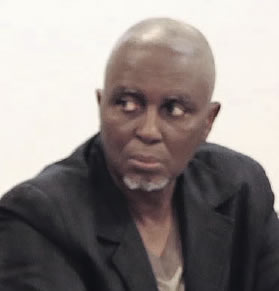
Mana Boubabakari |
Mana Boubabakari, the technical director of the “Lake Chad Basin Commission” (LCBC), gave a short but pointed outline of the current efforts to restore Lake Chad to re-establish the former level of Lake Chad and other wetlands through water transfer. The plan is to reverse the degradation of the ecosystem and establish the integrated management of water resources.
A masterplan to save Lake Chad and its environment was initially made at the 6th Summit of the Head of States and Government of the LCBC in N’Djamena on Oct. 28-29, 1987.
|
EIRNS
The proposed Transqua water transfer project from the Democratic Republic of Congo to Lake Chad. |
The earlier plan, the Transaqua project, developed by the Italian engineering firm Bonifica after the 1973 Sahel drought, was considered as diplomatically too complex and expensive in 1987, so the LCBC member states restricted themselves to considering the smaller alternative called the Ubangi-Lake Chad Water Transfer.
Now, Transaqua is back on the table. The project is technically and environmentally feasible, economically viable and crucial to reducing and eventually eliminating the current exodus of populations fleeing poverty and terrorism.
Transaqua will capture 100 billion of the Congo River’s 1.9 trillion cubic meters of water—five percent of the water that flows untapped into the Atlantic Ocean each year. It means building a 2,400-km navigable canal east of the Congo River, northwest across the Democratic Republic of Congo (DRC) to the Central African Republic (CAR) connecting to the Chari River.
The project will generate up to 30-35 billion kWh of hydroelectricity per year through the mass movement of water by gravity; expand a series of irrigated areas for crops or livestock over an area of 5-7 million hectares in the Sahel zone in Chad, north-east Nigeria, northern Cameroon and Niger. Transaqua will also intersect the Lagos-Mombasa Trans-African Highway (ports, river-roads goods distribution)
While Transaqua will transfer 3,200 cubic meters per second, the smaller Ubangi Water Transfer would only transfer 320 cubic meters. The latter could only raise the level of Lake Chad by 1 m compared with up to 5 m by Transaqua. Transaqua is a global infrastructure platform which will bring not only agricultural, demographic and industrial prosperity but also security, and education to at least 12 nations.
The good news is that an agreement was signed with Power China to study the best solutions. Also a convention between Power China and Bonifica will make sure that all the accumulated knowledge will not be lost. Things from here on are on the move and the international conference on saving Lake Chad in April 2018 should mark the beginning of a new era.
The New Silk Road will reconstruct war-torn Middle East countries
View full size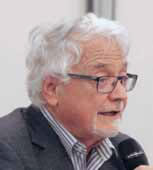
French Ambassador Michel Raimbaud |
French Ambassador Michel Raimbaud: OBOR (One Belt, One Road), so different than the “bomber democracy” of the West!
Former French ambassador to Mauritania, Sudan and Zimbabwe, and former director of the French “Office for the Protection of Refuges and Stateless Persons” (OFPRA), Michel Raimbaud, is known as a relentless critic of all brands of imperialism.
For him, China’s Belt and Road initiative definitely creates “a lot of trouble for the Anglo-Saxon geopoliticians” for whom those controlling what Mackinder branded the “Heartland” (Eurasia) would control the oceans, and therefore the world. Today, China’s New Silk Road policy also means a new era for the “Muslim Green Belt,” while the neo-conservatives’ “democratization projects” were a means to destroy those nations through atomization.
Beijing, according to Raimbaud, is no longer ashamed of its geo-economical ambitions: securitize its energy and raw material supplies by a “federative project” bolstering its economic influence in the 64 countries stretching from Eurasia to the African continent.
However, he added, it has to be underscored that “OBOR, is based on the constructive logic of cooperation diametrically opposed to the military and destructive approach adopted by the Unites States over the last quarter century.”
OBOR reaches 4.4 billion people, nearly 2/3 of the world population, comprised of 900 projects and $900 billion in investments, the equivalent of four times the Marshall Plan. By its geographic and financial scope, it cannot but attract the 16 countries of the Middle East and Northern Africa which make up the Silk Road Economic Belt and the resurrection of the ancient trade routes connecting Bahrain, Egypt, Iran, Iraq, Israel, Lebanon, Jordan, Kuwait, Oman, Palestine, Qatar, Saudi Arabia, Syria, Turkey, the UAE, and Yemen.” OBOR has nothing to do with George W. Bush’s “Greater Middle East,” a plan to conquer and break up the region, not the “win-win” policy of China, but the “lose-lose” policies of the neo-cons.
Raimbaud, praising the Schiller Institute’s program for the reconstruction of Syria and the World Land Bridge, described in great detail how three major countries, namely Iran, Syria and Lebanon have an established interest to see one of the three major economic corridors connecting China, Central Asia and South-East Asia reopened, as well as the return of the Maritime Silk roads. OBOR offers a different future than the “bomber democracy” of the West.
“Admittedly, the New Silk Road is a Chinese project, conceived, financed and applied under Chinese direction. OBOR is conceived as an instrument of influence, not as an instrument of charity, but it offers these three countries the perspective of stability, respectful cooperation and insurance against extremism and the threat of terrorism. It rebuilds their future.”
Yemen, from Felix Arabia
To Crimes of War
View full size
Paul Bonnenfant |
Paul Bonnenfant, former researcher at the Institute for Research and Study of the Arab and Muslim World, a project of France’s CNRS (National Center for Scientific Research), then spoke about Yemen, a country which was an important part of China’s Silk Road for many centuries and which is today being destroyed by a Saudi Coalition supported and armed by the Western powers.
After outlining the strategic reasons pushing the Saudis to do this, he described the terrible situation: 9,000 dead, 49,000 wounded, 3 million displaced—all the result of this war. Seventeen million Yemenites are suffering food insecurity (two-thirds of the population) of which seven million are threatened by famine. Four hundred-sixty thousand children need urgent food aid. According to the WHO, there could be 600,000 cases of cholera by end of 2017: The entire country has been affected, but cholera is highest in areas of the worst malnutrition. The main cause is lack of hygiene, lack of water, and the collapse of the health system. Saudi Arabia has systematically targeted water reservoirs, pumping installations, hospitals, and health centers. Bonnenfant went through the heavy destruction of the cultural patrimony including religious centers, ancient buildings, and manuscripts.
“Saudi Arabia and its allies are guilty of war crimes in Yemen,” he reported. While the Houthis have engaged in violations of human rights, “it is the Saudi led coalition which is the primary culprit accused by the NGOs.”
What can France do? Be coherent with its signing of “The Arms Trade Treaty” governing international weapons trade adopted in 2014 by the UN to which “France declares solemnly to attach the greatest importance.”
View full size cc/Ibrahem Qasim
Destroyed house in the south of Sana’a, Yemen, Dec. 6, 2015. |
Bonnenfant continued, “Those beautiful intentions and French declarations are totally contradicted by the facts. . . . the very official Report to the Parliament on the weapons sales by France in 2015, speaks of ‘economic success’ . . . a historic success which made of France the number two world exporter of weapons in 2015, a year during which France registered 16 billion Euros in contracts, of which three-fourths were orders destined for the Middle East.”
“I deplore that in March 2016, President Hollande presented the Saudi Interior minister, Mohammed bin Nayef with the Legion of Honor medal, an honor perhaps for that Prince, but no honor to the Legion of Honor.” The fact is that “civilians in Yemen are under the fire of the Leclerc tanks and the Mirage 2000s, which France sold respectively to the United Arab Emirates and to Qatar in preceding years. Saudi Arabia, the leader of the Coalition, was the number one client of France from 2009 to 2015. One can say, with no risk of being wrong, that a good part of those bombs, shells, and missiles which are harassing, killing, and wounding the Yemenite people and destroying their patrimony, are of French origin. That’s the precise point which depends on France, that is, on us.”
IV. The underlying economic principles of China’s New Silk Road
Creativity, R&D, Infrastructure, from Hamilton, Carey, and List, to LaRouche
View full size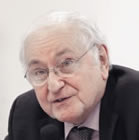
Jacques Cheminade |
Jacques Cheminade, economist and former candidate for President of France, presented a closing strategic report. He began, “It was in 1964, after France had recognized, on January 27, the People’s Republic of China and established diplomatic relations, that General de Gaulle declared, ‘It is not excluded that China becomes once again during the next century, what it was throughout the centuries, the greatest power of the Universe.’ ” Not because he appreciated Mao Zedong, but because he had a clear view into the future.
The prophetic words of de Gaulle have not yet been fully realized. But the road has been laid out as presented by Xi Jinping at the 19th Party Congress.
View full size Charles de Gaulle |
This ongoing transformation is in unprecedented in history, considering the number of people involved, and is due to two fundamental elements. First of all, China did not do what we did, in particular after 1971. The adoption by the Western countries of the British system of political economy had disastrous consequences; it was submission to a monetarist conception of the economy, defined by monetary profit. The most extreme element was the decision by the European Union to demand that member states include the revenues of drugs and of other illicit traffic in determining their GDP figures.
In that system, misappropriated credit is an instrument to maintain short and medium term financial indebtedness, in the least worst case to sustain consumption, and for the worst, to inflate the overblown financial bubble for financial gaming. Financial credit institutions acting in this way have, in fact, taken control of the nation states. You see at the Eurogroup, representatives of the IMF, of the ECB and of the European Commission speak before anyone else—the ministers or heads of states of the different countries, end up reduced to the role of yes men in paper straight-jackets. It is a well-known fact in the United States that, other than military spending, or spending associated with that sector, there has been no major investment in the last 50 years.
In direct contrast to that suicidal conception which always sacrifices long term interests, China chose a credit policy in favor of infrastructure, long term investments and low interest rates. True, $20 trillion in debt has accumulated in ten years, but $10 trillion have been invested in infrastructure. If we take as point of reference the total factor of productivity, an index measuring the impact of advanced technologies on physical productivity of labor, we see in the United States of Franklin Roosevelt productivity of 3 to 3.5%; and of same order in France and Germany and Europe starting in 1950, and 3.11% in China between 1999 and 2011 according to U.S. economic statistics.
View full size 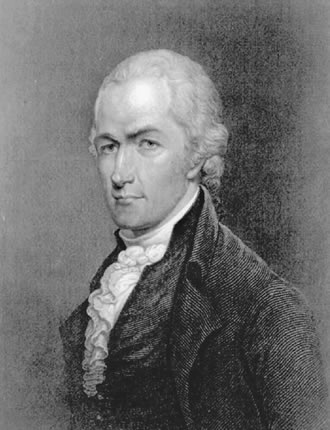 Alexander Hamilton View full size 
Mathew Carey
View full size 
Henry Carey
View full size 
Friedrich List
|
China has adopted the economic conception of public productive credit and of investments in infrastructure. These were the American policies of Alexander Hamilton, Mathew and Henry Carey, and the “American System” of Henry Clay. This conception was also presented by Friedrich List in his “National System of Economic Policy,” which is very well-known and appreciated in China, as is “indicative planning,” a French conception which China has adopted, while we in France have abandoned it.
The secret of the unprecedented development of China, on the one hand, is to be found in the qualities of the Chinese people, as was earlier said here, and in its own past industrial experience, through the Tang and the Song. These are the Confucian qualities which have been readopted today but these qualities are also an adoption of the principles which allowed the development of our own western economies, when they were still developing.
View full size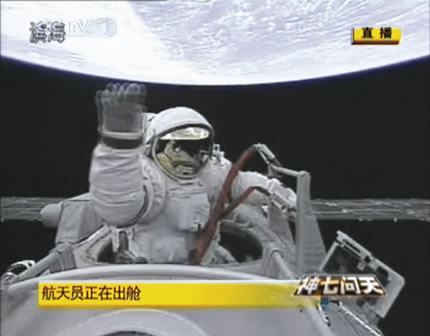 Xinhua
Chinese astronaut Zhai Zhigang waves to the camera as he conducts China’s first spacewalk, in this video grab taken on September 27, 2008. |
What are those principles? First, start from the fact that human creativity is the source and measure of the real economy, not financial profit expressed in monetary terms. The aim of economics is to create the most favorable conditions for the development of the creative capacities of human individuals at both the national level and in all other nations.
Secondly, concretely, it means putting a stop to the protection of financial speculation. That’s what Roosevelt applied under the name of Glass Steagall, or banking separation in the United States.
China has a system which is approximately equivalent to Glass Steagall, with the same impact; commercial banks have public support but not investments banks. True, China has non-banks which correspond to our speculative funds, but there, the whole system controls or can control the situation. This is the reason why in China, two-thirds of the credit allocated to the non-financial sector is concentrated in 22 large companies, which are focused on infrastructure and energy.
Thirdly, there is choosing investment-worthy projects and how to ensure the competence of those who lead them. The criteria established by Friedrich List, by Mathew and Henry Carey, and by advisors to Sergei Witte in Russia, and even more, by our economic planners after the war, is that of a bet on the future, the bet in France, after the war, on our indicative planning, and that of the KfW in Germany and the criteria of those bets, are the intensity of capital investments, i.e. physical capital—generally speaking the machines and the human capital, oriented towards a maximization of production and the principle of least action, i.e. a maximization of the free energy produced, relative to the energy used by the system: The increase, then, of the energy flux density and of technologies. Physical production with a constant increase per capita, per unit of surface and unit of matter used by the system, with the objective of long term investment, or as the Chinese call it, “patient capital.” Lastly: the improvement of the quality of human labor, training and education to ever higher levels in order to organize higher platforms of the system.
Those three fundamental orientations cannot express themselves concretely except on two conditions. The first is their inter-connectivity: between investment in infrastructure, in energy, in transports and in services associated with them, and then with the school system, the health system and in research, with a transformation principle being the common denominator in everything.
The second, more important, is the improvement of the quality of labor. Investment must go to fundamental discoveries, their technological applications and the innovation of those applications. China has thus gone from innovation to technological applications and is at this point at the level of fundamental discoveries. It’s a dynamic whole: education of labor from school age and continuing throughout life, and the great projects—space, nuclear energy, advanced technologies in sectors which can generate an environment of research and of increase in the density of technologies in use and the criteria that must define that choice. It is there where human creation expresses itself, where investments must be made.
View full size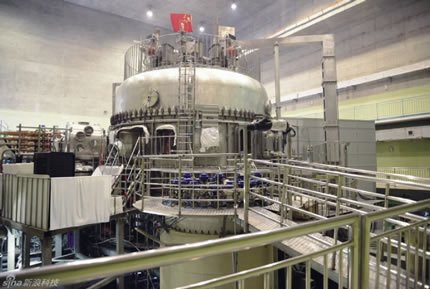 sina.com.cn
China’s Experimental Advanced Superconducting Tokamak (EAST). |
The question is not to create “Homo Deus”, who masters NBIC technologies (Nano, Bio, Info, Cognitive), technologies—technologies which are essential, if they are associated with the transformation of the physical economy, but which can, however, become (in the logic of “homo deus”), and this is happening in front of our eyes, disastrous, if these technologies are seen as things in themselves. Clearly, in and by themselves, information technologies have not led to any increase in real productivity.
Robert Gordon, in the “Rise and Fall of American Growth” demonstrates this well. This means, to be even more clear, that in order to go to space, you have to have propulsion by the highest technologies, i.e. thermonuclear controlled fusion with the contribution of robotics and digital technologies in order to manage and control processes that go beyond human sense-perception. It’s that combination that allows us to go towards the future.
Lyndon LaRouche has gone further than taking into account these principles, by establishing the unified criterion underlying the global dynamic of progress. This is his Potential Relative Population Density of society. Relative means the increase in the supporting capacity made possible by the introduction of constant new fundamental discoveries in the form of new technologies applying discoveries of those new physical principles. The Russian scientist and expert in the physical economy of space travel, Pobisk Kuznetsov, baptized that principle, with the name of the “La” principle and many Russian universities speak about this concept, while the ignorance in the West is total concerning this contribution.
Today, this perspective is expressed in what our American colleagues call Lyndon LaRouche’s Four Laws. Strict Banking separation, Glass Steagall, to bring Wall Street and its speculations to an end, a policy of productive public credit to relaunch the economy through real development, a true national bank, not a central bank under the control of private speculative financial forces—as are the Federal Reserve and the European central bank—and investment in the highest energy flux density, i.e. in the energy which we know today as thermonuclear controlled fusion and which tomorrow could be matter/antimatter.
Let’s now take Xi Jinping’s terms, as he expressed them with his economic advisors: a win-win system founded on mutual advantage, investment in infrastructure and in the most advanced technologies, “patient capital,” i.e. long term, in a society which is innovative in principle, and finally an inclusive interconnected system in each element of this dynamic.
Let us say it bluntly. The question is not to globalize or to de-globalize. We must recognize that for 25 years international relations, since the fall of the Berlin Wall, were wasted and that those wrong policies are leading us today to financial chaos, to the war of all against all and that this will lead us to armed conflict if we don’t change the direction.
China and the BRICS offer us the possibility for change, a change of paradigm as Mrs. LaRouche called it, and of which I have tried to develop the underlying principles. This means we have to rediscover our true selves, come back to the best part of our historic contribution. It is a question of will, of what the Americans call leadership at a moment of great crisis, having the courage to confront the financial dictatorship, wrongly called liberalism.
Let us bet therefore on peace. I think this is the commitment we must make today.


